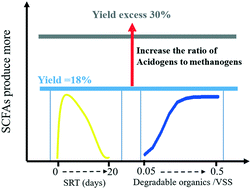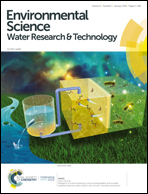Short-chain fatty acid (SCFA) production maximization by modeling thermophilic sludge fermentation†
Abstract
Producing more versatile green chemicals such as short-chain fatty acids (SCFAs) from waste activated sludge (WAS) via fermentation is a promising approach in wastewater treatment. In this study, we investigated how SCFA production can be maximized within wastewater treatment plants. An ordinary differential equation model was devised that encompasses organic inputs to a reactor as well as acetogenic and methanogenic bacterial populations. The model was calibrated and validated on an independent set of data during thermophilic sludge fermentation. A series of experiments were performed to determine the effects of reactor parameters, such as organic inputs and solid retention time (SRT), on SCFA production. Model simulation results show that optimization of SRT plays an important role in improving SCFA production. SCFA production can be enhanced with an increase in biodegradable particulate organic matter, an increase in acidogenic bacteria or a decrease in methanogens in the feed sludge. The maximum SCFA yield has been proven to benefit from thermophilic fermentation at a temperature of up to 50 °C, in which the maximum SCFA yield reaches 18% per VSS in terms of COD. The model predictions indicated that a high ratio of acidogenic bacteria to methanogens (i.e., 2 : 1) in the WAS is critical to achieve a maximum yield of approximately 30%.



 Please wait while we load your content...
Please wait while we load your content...